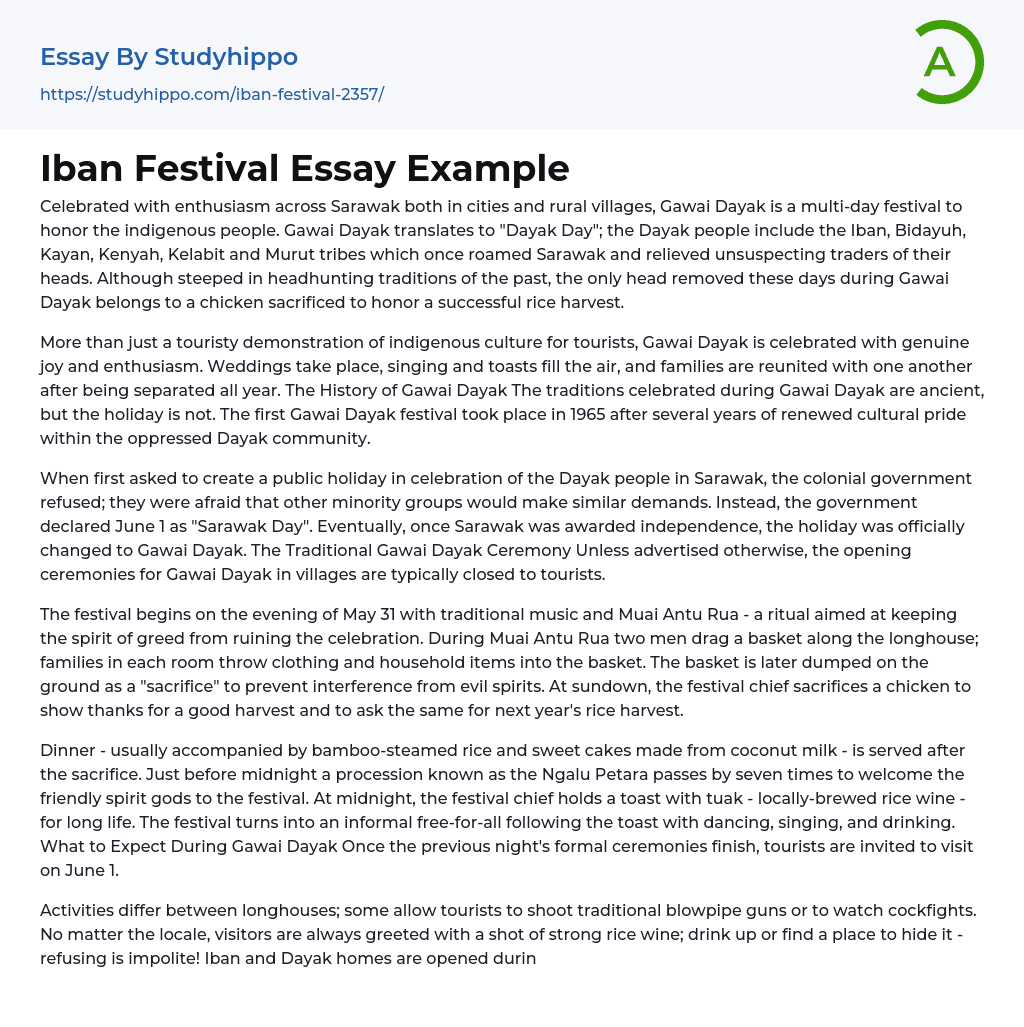Celebrated with enthusiasm across Sarawak both in cities and rural villages, Gawai Dayak is a multi-day festival to honor the indigenous people. Gawai Dayak translates to "Dayak Day"; the Dayak people include the Iban, Bidayuh, Kayan, Kenyah, Kelabit and Murut tribes which once roamed Sarawak and relieved unsuspecting traders of their heads. Although steeped in headhunting traditions of the past, the only head removed these days during Gawai Dayak belongs to a chicken sacrificed to honor a successful rice harvest.
More than just a touristy demonstration of indigenous culture for tourists, Gawai Dayak is celebrated with genuine joy and enthusiasm. Weddings take place, singing and toasts fill the air, and families are reunited with one another after being separated all year. The History of Gawai Dayak The traditions celebrated during Gawai Dayak are ancient, but the holiday is
...not. The first Gawai Dayak festival took place in 1965 after several years of renewed cultural pride within the oppressed Dayak community.
When first asked to create a public holiday in celebration of the Dayak people in Sarawak, the colonial government refused; they were afraid that other minority groups would make similar demands. Instead, the government declared June 1 as "Sarawak Day". Eventually, once Sarawak was awarded independence, the holiday was officially changed to Gawai Dayak. The Traditional Gawai Dayak Ceremony Unless advertised otherwise, the opening ceremonies for Gawai Dayak in villages are typically closed to tourists.
The festival begins on the evening of May 31 with traditional music and Muai Antu Rua - a ritual aimed at keeping the spirit of greed from ruining the celebration. During Muai Antu Rua two men drag a basket along the longhouse; familie
in each room throw clothing and household items into the basket. The basket is later dumped on the ground as a "sacrifice" to prevent interference from evil spirits. At sundown, the festival chief sacrifices a chicken to show thanks for a good harvest and to ask the same for next year's rice harvest.
Dinner - usually accompanied by bamboo-steamed rice and sweet cakes made from coconut milk - is served after the sacrifice. Just before midnight a procession known as the Ngalu Petara passes by seven times to welcome the friendly spirit gods to the festival. At midnight, the festival chief holds a toast with tuak - locally-brewed rice wine - for long life. The festival turns into an informal free-for-all following the toast with dancing, singing, and drinking. What to Expect During Gawai Dayak Once the previous night's formal ceremonies finish, tourists are invited to visit on June 1.
Activities differ between longhouses; some allow tourists to shoot traditional blowpipe guns or to watch cockfights. No matter the locale, visitors are always greeted with a shot of strong rice wine; drink up or find a place to hide it - refusing is impolite! Iban and Dayak homes are opened during Gawai Dayak, allowing visitors a glimpse of daily life. Tourists are invited to wear colorful costumes for photos, participate in traditional dances, and sample delicious cakes and treats. Witnessing the Gawai Dayak Festival
Although celebrated all over Sarawak in Borneo, your best bet for seeing Gawai Dayak festivities is near the capital of Kuching. The Sarawak Cultural Village - the same venue used annually for the Rainforest Music Festival - is a popular and convenient place for
tourists to learn more about indigenous culture. Kuching typically holds a celebration on May 31 at the Civic Centre which includes dinner, dancing, and even a beauty pageant. Do not expect to arrive on May 31 to join the Gawai Dayak celebration; Kuching is busier than ever with parades and demonstrations along the waterfront that begin a week prior to Gawai Dayak.
Another option for the more adventurous is to make your way up the river from Sibu to the small village of Kapit and arrange for a visit to a local family's traditional longhouse. There is a push within the Dayak community to unify the celebration, however for now Gawai Dayak remains mostly incongruous with each longhouse holding separate events and itineraries. Do not expect any less from the festival - as many as 30 families can occupy a single longhouse! Read more about getting around Sarawak.
Gawai Dayak in Modern Times Forget the romantic stereotypes - not all of Sarawak's indigenous people still live in longhouses or choose to don a traditional costume during Gawai Dayak. Many Dayak people have moved from their rural homes into the cities in search of work. Urban Dayak communities may choose to celebrate their holiday simply by taking time off work - a rare occasion - to visit family outside of the city. Christian Dayaks often attend mass at a church and then celebrate with dinner in a restaurant.




